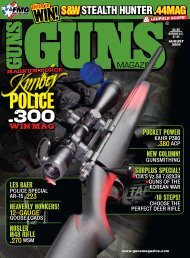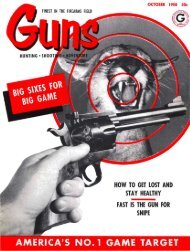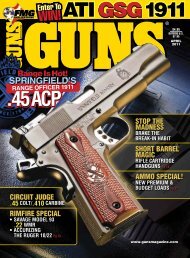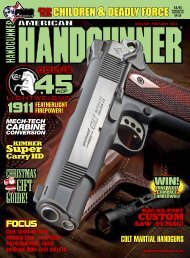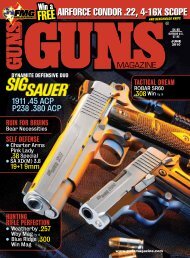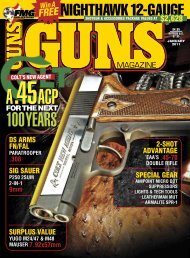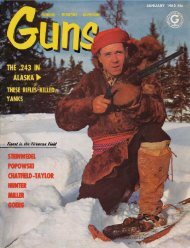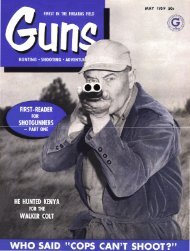Guns 2012-08.pdf - Jeffersonian
Guns 2012-08.pdf - Jeffersonian
Guns 2012-08.pdf - Jeffersonian
Create successful ePaper yourself
Turn your PDF publications into a flip-book with our unique Google optimized e-Paper software.
Mike “Duke” Venturino<br />
Photos: Yvonne Venturino<br />
omehow or another during the decade-long process<br />
Sof assembling my World War II firearms collection<br />
numbering about four score and 10 at this writing, I’ve<br />
become severely infected with sniper rifle mania. Some<br />
of these scoped sniper rifles are originals I bought.<br />
Others are reproductions I had built. One is a replica sold<br />
complete with scope which can be purchased right off the<br />
shelf. All are shooters.<br />
My mania has even caused me to<br />
buy a couple of post-WWII sniper<br />
rifles simply because of their accuracy<br />
reputations. One is a 1950s vintage<br />
Swedish Mauser Model 41b 6.5x55mm<br />
mounted with 4X Ajack scope. Model<br />
41bs are merely Mauser Model 1896s<br />
fitted with optical sights and so mine<br />
is dated 1919 on the front receiver ring.<br />
The US Model 1903A4<br />
was the US Army’s<br />
only official sniper<br />
rifle in World War II.<br />
It is more accurate than the average<br />
21st century sporting rifle. The second<br />
is a reproduction of the 1960s US<br />
Marine Corps’ 7.62mm NATO Model<br />
40. As were the USMC originals it’s a<br />
Remington Model 700 with varmintweight<br />
barrel, Parkerized metal<br />
finish and oiled stock. Caliber is .308<br />
Winchester, the civilian alter ego of the<br />
NATO round. USMC Model 40s were<br />
issued with Redfield 3-9X rangefinder<br />
scopes. Because my repro Model 40<br />
easily groups minute of angle (MOA)<br />
I’ve fitted it with a new Weaver 3-15X<br />
tactical scope with precise 1/8-MOA<br />
click adjustments.<br />
My least valued sniper rifle is the<br />
Japanese Type 97 6.5x50mm. Why is<br />
it so disrespected? Type 97s are rare<br />
collectors’ items but I value mine less<br />
because in my opinion the Japanese had<br />
little idea of what a good rifle should<br />
be. That fact is not surprising because<br />
as a nation Japan has much more a<br />
tradition of sharp objects instead of<br />
firearms. The Japanese mounted 2.5X<br />
scopes on the left side of Type 97<br />
receivers in quick detachable mounts.<br />
The scopes themselves have no<br />
provision for adjustments. Riflescope<br />
zeroing was done at arsenals<br />
by tweaking the mounts. Soldiers<br />
were not supposed to mess with them<br />
thereafter. Instead the scope has a<br />
complex reticle with various elevation<br />
and windage hash marks. Snipers were<br />
expected to memorize where their<br />
rifles hit at different ranges and in<br />
different conditions with the various<br />
marks. It took an extreme amount of<br />
patience, coupled with a plentitude of<br />
ammunition and a friend’s extra set of<br />
hands and IQ to finally get mine sighted<br />
in adequately.<br />
A sniper rifle I don’t disrespect but<br />
am not overly enamored with is my<br />
British one. It is the No. 4 Mk I(T)<br />
wearing the No. 32 3.5X scope. Of<br />
course caliber is .303 British. The heavy<br />
scope mount bolts to the left side of the<br />
receiver with two large thumb screws.<br />
This makes rifle weight a full 12 pounds.<br />
Its scope must be removed before the<br />
bolt can be taken out in order to clean<br />
the rifle from the breech.<br />
Also this rifle’s bolt locks at the rear<br />
which is an unkindness to handloaders,<br />
a thought its designers never had in<br />
their heads. Therefore its cases tend to<br />
separate after just a couple loadings.<br />
(I know the problem can be helped<br />
by neck sizing but since I own six<br />
.303-chambered firearms including a<br />
machine gun, keeping brass sorted for<br />
each is unrealistic.) Also my British<br />
sniper rifle isn’t especially accurate,<br />
being a plus/minus 2-MOA shooter<br />
even with my best handloads.<br />
On the other end of my favorite<br />
spectrum are German, American, and<br />
surprisingly—Finnish sniper rifles. If<br />
there was ever a “nation of riflemen” it<br />
was Finland. Their story is too long to<br />
get into here so we’ll limit this to one<br />
of their sniper rifles. It is the Model<br />
1939 7.62x54mmR. During WWII they<br />
fitted up a few hundred with captured<br />
Russian 4X PE scopes and mounts<br />
(Source: Rifles Of The White Death by<br />
60<br />
WWW.GUNSMAGAZINE.COM • AUGUST <strong>2012</strong>




